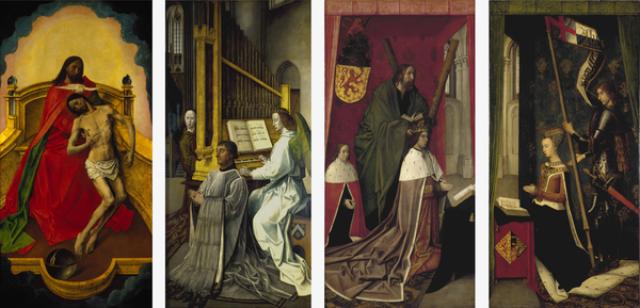Portraiture grew in popularity in Scotland from around the turn of the 16th century. Individual representation became increasingly important at court for recording likenesses and displaying dynastic links and political allegiances, and for negotiating and commemorating marriages. Some important portraits were already known in Scotland, such as Hugo Van der Goes’s altarpiece depicting James III, Queen Margaret of Denmark, Prince James and Edward Bonkil. Although painted in Ghent, it was displayed in the Trinity College Chapel in Edinburgh.
Scottish trading links with the Low Countries, where there was an established tradition of portrait painting, resulted in an influx of Netherlandish artists in the 16th century such as Arnold Bronckorst, Adrian Vanson, and Adam de Colone. In 1581, Bronckorst became James VI’s official painter, producing portraits of the king and his court, including the regent, James Douglas 4th Earl of Morton.
The first great native-born Scottish portraitist was George Jamesone, whose paintings brought him fame and wealth. His self-portrait in a room full of pictures shows him as a gentleman-artist, his profession elevated from the level of craftsmanship, and he points at the portraits through which he gained his status. The artist David Scougall came from a family of painters, but stylistically followed after Jamesone. In Scougall’s portraits, such as his unflattering image of Archibald Campbell, 1st Marquess of Argyll, his debt to Jamesone is clear.
By the beginning of the 18th century an increasing number of people from across society were buying, displaying and distributing portraits, either of themselves, their families, or their friends. Portraits were produced in various sizes, from life-size full-lengths to tiny miniatures. Dynamic poses were introduced and sitters were often shown in the guise of religious or mythological figures to add a different level of meaning to their portrait.
Prior to his move to London, William Aikman was the leading portraitist in early eighteenth-century Scotland. The much celebrated Allan Ramsay, whose sophisticated, continental style made him the leading portraitist of the early Enlightenment, followed Aikman’s example and made for London, as did James Tassie. Tassie made highly fashionable, neo-classical cameo medallions.
The great artist of the late Enlightenment was Sir Henry Raeburn. He painted some of Scotland’s most iconic portraits, such as Macdonell of Glengarry, in which the figure is enlivened by dramatic lighting and loose brushstrokes. His studio’s enormous output of work was a testament to his popularity.
Portraiture remained popular throughout the nineteenth century, and often reflected fashionable contemporary tastes, such as sentimentality. This is evident in Robert Scott Lauder’s portrait of Walters Scott’s daughter Charlotte and her husband, which was painted as a memorial to their relationship following Charlotte’s death.
The introduction of photography in the early nineteenth century presented a completely new method of capturing likenesses. It also heralded the beginning of documentary portraiture such as the calotype photographs by the pioneers of the genre Robert Adamson and David Octavius Hill.

The social upheavals of the 20th century saw portraiture come in and out of fashion, but the modern and post-modern art movements, as well as technological advancements such as digital photography, saw an expansion of possibilities for creating portraits that had now become more socially inclusive. David Mach’s large postcard and photograph collages of sports personalities, and Calum Colvin’s ‘constructed photography’, both show an original approach to the tradition of capturing a likeness.
Likewise, Douglas Gordon’s conceptual self portrait challenges viewers to think about human nature and the world they inhabit. By questioning what a portrait is, he follows a long tradition of artists who have explored the limitless possibilities of capturing the Scottish face.












